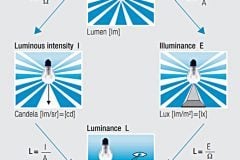 Light has intrigued humankind for centuries. The most ancient theories considered light as something emitted by the human eye. Later on, it was understood that light should come from the objects seen and that it entered the eye producing the feeling of vision.
Light has intrigued humankind for centuries. The most ancient theories considered light as something emitted by the human eye. Later on, it was understood that light should come from the objects seen and that it entered the eye producing the feeling of vision.
The question of whether light is composed by a beam of particles or it is a certain type of wave movement has frequently been studied in the history of science. Between the proponents and defendants of the corpuscular theory of light, the most influential was undoubtedly Newton. Using the above mentioned theory, he was able to explain the laws of reflection and refraction. Nevertheless, his deduction of the law of refraction was based on the hypothesis that light moves more quickly in water or in glass than in air.
Some time later, the hypothesis was proved to be wrong. The main proponents of the wave theory of light were Christian Huygens and Robert Hooke. Using their own theory of wave propagation, Huygens was able to explain reflection and refraction supposing that light travels more slowly in glass or in water than in air. Newton realized about the advantages of the wave theory of light, particularly because it explained colours formed by thin films, which he had studied very thoroughly.
Not withstanding, he rejected the wave theory due to the apparent rectilinear propagation of light. In his time, diffraction of the luminous beam, which allows to evade objects, had not yet been observed.
Newton’s corpuscular theory of light was accepted for more than a century. After some time, in 1801, Thomas Young revitalized the wave theory of light. He was one of the first scientists to introduce the idea of interference as a wave phenomenon present both in the light and in the sound. His observations of interferences obtained from light were a clear demonstration of their wave nature.
Nevertheless, Young’s research was not known by the scientific community for more than ten years. Probably, the most important breakthrough regarding a general acceptance of the wave theory of light is due to the French physicist Augustin Fresnel (1782-1827), who conducted thorough experiments on interference and diffraction. He also developed a wave theory based on a solid mathematical foundation. In 1850, Jean Foucault measured the speed of light in water and checked that it is slower than in air.
Thus, he finally destroyed Newton’s corpuscular theory of light. In 1860, James Clerk Maxwell published his electromagnetic mathematical theory which preceded the existence of electromagnetic waves. These waves propagated with a calculated speed through electricity and magnetism laws which was equivalent in value to 3 x 108 m/s, the same value than the speed of light. Maxwell’s theory was confirmed by Hertz in 1887 who used a tuned electric circuit to generate waves and another similar circuit to detect them. In the second half of the 19th century, Kirchoff and other scientists applied Maxwell’s laws to explain interference and diffraction of light and other electromagnetic waves and support Huygens’ empirical methods of wave construction on a solid mathematical basis.
Although wave theory is generally correct when propagation of light is described (and of other electromagnetic waves), it fails when other light properties are to be explained, specially the interaction of light with matter. Hertz, in a famous experiment in 1887 confirmed Maxwell’s wave theory, and he also discovered the photoelectric effect. Such an effect can also be explained by means of a model of particles for light, as Einstein proved only a few years later. This way, a new corpuscular model of light was introduced.
The particles of light are known as photons and energy E of a photon is related to frequency f of the luminous wave associated by Einstein’s famous ratio E = h · f (h = Planck’s constant).
A complete understanding of dual nature of light was not achieved before the 20’s in the 20th century. Experiments conducted by scientists of the time (Davisson, Germer, Thompson and others) proved that electrons (and other “particles”) also had a dual nature and presented interference and diffraction properties besides their well-known particle properties.
In brief, the modern theory of quantum mechanics of luminous radiation accepts the fact that light seems to have a dual nature. On the one hand, light propagation phenomena find a better explanation within Maxwell’s electromagnetic theory (electromagnetic wave fundamental nature). On the other hand, mutual action between light and matter, in the processes of absorption and emission, is a photoelectric phenomenon (corpuscular nature).










